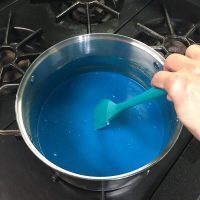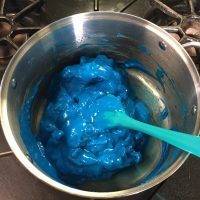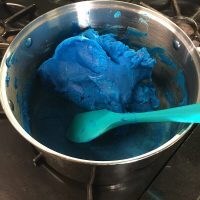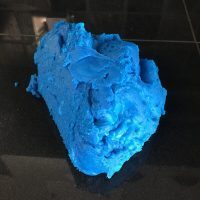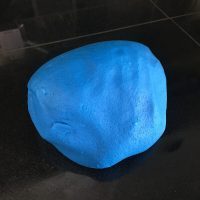
Play Dough. Loved by children for generations, full of learning potential, and easy to make on your own with some common supplies and readily available tools. Here’s my take on a basic play dough recipe. This write-up is based on the play dough recipe Lisa Murphy shares on page 115 of the wonderful Ooey Gooey Handbook. I’ve been using it for years.
Supplies
- 3 Cups Flour
- 1.5 Cups Salt
- 3 Cups Water
- 5 Tablespoons Cooking Oil
- 6 Teaspoons Cream of Tarter
- Liquid Water Color or Food Coloring If You Want Colored Play Dough
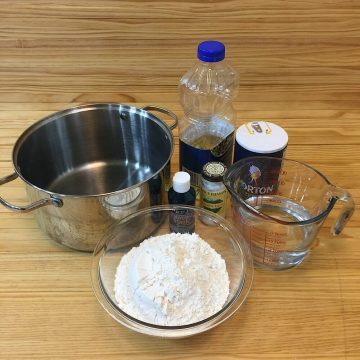
Tools
- Large Pot
- Heat Resistant Spatial
- Assorted Measuring Cups and Spoons
- A Stove Burner
- A countertop or tabletop
Mix The Dry Goods
- Add the Flour, Salt, and Cream of Tartar to the Large Pot.
- Mix well. Your goal here is to evenly combine the three dry ingredients.
Add The Liquids
- Add the Oil to the dry goods in the Large Pot.
- Add Water and Coloring to the Large Pot. Determining exactly how much coloring to add is more art than science, AND adding the correct amount of liquid is really important. Here’s how to make sure you get it right: make sure Water + Coloring = 3 cups. No more. No less.
- You could use an electric mixer, but doing it by hand is pretty simple. Using a mixer ends up taking more time and work since you have to get the mixer out, clean the mixer, and put it away.
Heat It Up
- Set the burner to Medium-Low. See how I used Bold and Italic?–This is really important. If the heat is too high, your play dough will dry out as you cook it and it will be ruined. Ruined, I tell you! If you’re not exactly sure what Medium-Low is, remember that it’s better for the heat to be too low than too high. Too high means ruined play dough. Too low means it take a little longer to cook. (Cooking at lower than medium-low may actually be the best option if you have kids helping since the extended cook time will mean more kids can take a turn at stirring.)
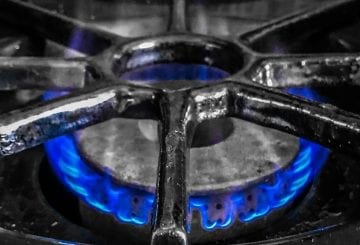
- Stir, stir, stir. Scrape the sides, scrape the sides, scrape the sides. The goal is to thoroughly mix the solids and liquids and have them slowly form a ball. Sloooooooooowly.
You Need to Knead
- After you achieve balling, turn off the heat, transfer the dough to a flat surface, and knead it thoroughly. This process both finishes the mixing process and starts the cooling process.
Notes
- Exposure to air dries out play dough. When it’s not in use, protect it. After it is thoroughly cooled, store dough in the airtight container of your choice. Choose thoughtfully. Lidded containers are durable, but your dough will dry out if the lid is not attached correctly. Many plastic bags indicate they are sealed when you close them, but they are also easily punctured by little fingers or hands manipulating scissors, pencils, and other pointy tools. The safest place to store your dough is an airtight safe with a biometric locking mechanism. Or, you can make a fresh batch when needed.
- You could double the recipe if you need lots of play dough, and who doesn’t. Just remember that that requires a lot more stirring. In my experience, it’s easier to mix up multiple batches.
- If something goes wrong, it’ll probably be one of these two things: You set the heat too high (above medium-low) or you had too much liquid (include coloring as part of the 3 cups water).
- No need for coloring. Naked play dough is just fine.
- Check out DIY instructions for my Play Dough Rollers and Play Dough Stamps for more dough-riffic play ideas.
Contribute content to Playvolution HQ
Brought to you by Explorations Early Learning
Browse Trainings
Author
Jeff Johnson is an early learning trainer, podcaster, and author who founded Explorations Early Learning, Playvolution HQ, and Play Haven.
In-Person And Online Training
Learn how to book an in-person or online training for your organization on these early learning topics.
Support The Site
I participate in the Amazon Services LLC Associates Program, an affiliate advertising program designed to provide a means for me to earn fees
by linking to Amazon.com and affiliate sites.
Thanks To Our Patrons
This post was made possible by patrons like these, who generously fund our work:
Supporters
Lissadell Greene Stephanie Goloway Jennifer Stark
Lagina Kozak Michelle Hankins
Marie Messinger Tamara L. Lakin
Fans
Jen Flemming Lizz Nolasco Cynthia J Bays
Susan Warner Kelly Sigalove Shawn Wolf
Vittoria Jimerson Codee Gilbert Wendy Tedford
Monica Morrell Pam Soloman Melissa Franklin
Teresa Watson Erika Felt Autumn Peele
Melissa Taylor Jahmeela Robinson Stacie Manning
Amber Maurina Terra Calamari Anne Jackson
Lagina Kozak Samantha Yeager-Cheevers
Elizebeth McCoy Sammy Cousens Ellen Cogan



